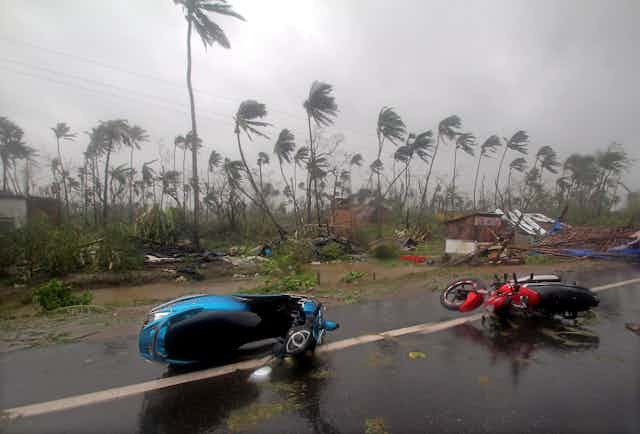Fani, a rare summer cyclone in the Bay of Bengal, hit eastern India on May 3. It is one of the strongest cyclones to have hit India in the last 20 years, according to the Indian government’s meteorological department. Storm surges and powerful winds reaching 125mph blew off roofs, damaged power lines and uprooted countless trees.
But the worst-affected state, Odisha, has been successful in keeping the loss of life and numbers of affected people to a minimum. This is the result of a very effective strategy of disaster preparation and quick responding.
The United Nations office for Disaster Risk Deduction (UNISDR) and other organisations have hailed government and volunteer efforts that have ensured the levels of destruction have been kept to a minimum. According to official estimates, 64 people lost their lives due to the devastating cyclone Fani. But considering the power of the cyclone, it is remarkable that more lives have not been lost.
To put the death toll in perspective, the 1999 Odisha cyclone (which had 155mph winds) killed 9,658 people and caused US$2.5 billion in damages in the state. It was this super cyclone in 1999 that led the state to become better prepared for future cyclones.
The government’s “zero casualty” policy for natural disasters and the near accuracy of the India meteorological department’s early warning system have helped reduce the possibility of deaths from cyclone Fani. A record 1.2m people (equal to the population of Mauritius) were evacuated in less than 48 hours, and almost 7,000 kitchens, catering to 9,000 shelters, were made functional overnight. This mammoth exercise involved more than 45,000 volunteers.
The statistics are striking when compared to the impact of recent big weather events around the world. When Hurricane Maria hit Puerto Rico in 2017 with wind speeds of 175mph, it caused a death toll of 2,975. The same year, Hurricane Harvey struck Texas with winds of 130mph and caused devastating flooding. There was US$125 billion in damage and at least 68 direct storm-related deaths reported in Texas. Most recently, cyclone Idai hit Mozambique on March 14 and ripped through Madagascar, Malawi and Zimbabwe, with more than 1,000 people feared dead.
So the Indian state of Odisha’s ability to put such an effective disaster management plan in place and save thousands of lives is a template that the world can learn from. This, after all, is a state where the average income is less than US$5 a day. We identify four key takeaways from Odisha.
1. Build a relief infrastructure
Until 1999, Odisha didn’t have a well laid out plan for disaster management. Two months after the cyclone hit, the Odisha State Disaster Management Authority was set up and plans put in place. Around 900 cyclone shelters have been built in vulnerable pockets of the state, with systems in place for the evacuation of hundreds of thousands of people. By 2001, Odisha Disaster Rapid Action Force was also set up to conduct rescue operations and distribute relief.

There is a clear command and control structure for disaster relief and there are clear protocols in place for carrying out relief operations. These were successfully used in managing cyclone Phailin in 2013 (a storm five times the size of hurricane Katrina), cyclone Hudhud in 2014 and cyclone Fani.
2. Accuracy of early warning systems
The India Meteorological Department has built an effective service to predict accurate timings of cyclone formation in the Bay of Bengal and when it will make landfall along India’s coastline. This early warning system enables the state to be disaster ready and minimise loss of lives. It’s then crucial that people follow the protocols in place when the warnings come in.
3. Clear communication plan
Roughly 2.6m text messages were sent to locals in clear language before cyclone Fani hit, keeping those potentially affected alert. Regular press briefings were made by officials to update people of the approaching cyclone. People were repeatedly advised over all forms of media not to panic and given clear “do and don’ts”. This helped in the record evacuation of 1.2m people to safe buildings.
4. Effective co-ordination of groups
Preparations to fight the onslaught of Fani involved a number of government agencies, as well as local community groups and volunteers working together. The government’s disaster response forces were pre-positioned in vulnerable locations, food packets for air-dropping were made ready for air force helicopters to drop to people. Senior state officials and police officers were sent to the affected districts to co-ordinate efforts of various agencies.
Cyclone Fani has, however, left a fury of damage to properties and public infrastructure. The post-cyclone recovery will be a daunting challenge to the administration in Odisha, demanding a lot of resources. In the aftermath of the 1999 super cyclone, the state relied on a number of community-based groups and volunteers to help rebuild communities. The same goes for today, but they are in a much better position thanks to the disaster preparedness and risk mitigation followed before the storm hit.

